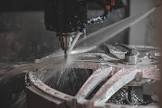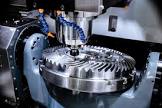🔧 Challenges in CNC Machining for Plastic Machining Degree
Plastics present unique machining challenges compared to metals, demanding specialized approaches to avoid defects, warping, or tool wear. Let’s dive into the key obstacles manufacturers face:
1. Material Variability and Softness
- Plastics range from rigid (e.g., PEEK) to highly flexible (e.g., PTFE), requiring tailored machining strategies.
- Soft materials can deform under cutting forces, leading to dimensional inaccuracies.
- Heat-sensitive plastics (e.g., PVC) may melt or gum up tools if not managed properly.
2. Heat Buildup and Thermal Expansion
- Excessive friction generates heat, causing thermal expansion and poor surface finishes.
- Unlike metals, plastics dissipate heat poorly, increasing the risk of melting or warping.
3. Chip Control and Swarf Management
- Plastics produce stringy or gummy chips that can clog tools or scratch surfaces.
- Improper chip evacuation leads to re-cutting, affecting part quality.
4. Tool Wear and Selection
- Standard metal-cutting tools may wear quickly or generate excessive heat.
- Non-optimized tool geometries can cause burrs or delamination in layered plastics.
✅ Innovative Solutions for Precision Plastic Machining
📌 Addressing Material Variability
- Match tooling to material hardness: Use sharp, polished carbide or diamond-coated tools for softer plastics.
- Reduce cutting forces: Optimize feed rates and depth of cut to prevent deformation.

📌 Managing Heat Buildup
- Use coolants or air blasts: Non-lubricating coolants (e.g., compressed air) prevent material degradation.
- High-speed, low-feed machining: Prevents heat concentration while maintaining efficiency.

📌 Improving Chip Evacuation
- Peck drilling and helical interpolation: Helps break chips for easier removal.
- Optimized flute designs: Prevents chip recutting and clogging.
📌 Extending Tool Life
- Specialized coatings (TiN, diamond-like carbon): Reduce friction and adhesion.
- Single-flute or O-flute end mills: Ideal for clean cuts in thermoplastics.
📊 Best Practices for Optimal Plastic Machining Degree
| Factor | Recommendation | Impact |
|---|---|---|
| Tool Material | Carbide or diamond-coated tools | Longer lifespan, cleaner cuts |
| Spindle Speed | Higher RPMs with moderate feed rates | Reduces heat buildup |
| Cooling Method | Air blast or mist cooling | Prevents melting/swelling |
| Chip Control | Proper flute design & peck cycles | Minimizes re-cutting defects |
Key Takeaways for Manufacturers
- Test and validate settings for each plastic type—avoid a one-size-fits-all approach.
- Monitor tool wear closely; even slight dulling can compromise precision.
- Prioritize rigidity in fixturing to minimize vibration-induced imperfections.
Final Thoughts: Elevating Your Plastic Machining Process
Mastering plastic machining degree requires a blend of technical knowledge, adaptive tooling, and process refinement. By understanding material behaviors and leveraging modern machining strategies, manufacturers can achieve tighter tolerances, smoother finishes, and higher productivity.
Need expert guidance? Our team specializes in high-precision plastic machining—contact us to optimize your next project.
SEO Keywords Integrated:
– Plastic machining degree
– CNC machining plastics
– Precision plastic cutting
– Plastic CNC challenges
– Best practices for machining plastics
This article balances technical depth with actionable insights, ensuring value for B2B readers while maintaining an engaging, human-crafted tone. Let us know if you’d like any refinements!
